Work, more work and a Rugby League World Cup (you should watch the games, they're all live on BBC and it's been great) have meant I'm behind in updating the blog.
James pulled together his usual rag-tag band of brigands and desperate men to put on a "Morris and Chums" game at Partizan a few weeks ago. This time new chum Chris who has a huge Wars of the Roses collection suggested Mortimer's Cross. I've been a fan of the battle for a while - at least partly because it's in beautiful Herefordshire and a short distance from the very lovely Croft Castle one of my favourite National Trust places. The Lancastrians I've been painting with Billhooks in mind were loosely based on the forces at Mortimer's Cross.
Obviously we decided to use James' forthcoming Midgard rules (out next year from the TFL Reisswitz press).
On the day we had a fine old time chatting to people and rolling dice. Some of the archaeologists investigating the battle site popped by along with lots of other people familiar with the battle and many more who knew little.
One chap saw we had cannon on the table, loudly expressed his derision and stomped off before anyone could tell him that contemporary cannon ball have been found in the area according to the Battlefield Trust - but hey, what do they know? Also it's just a game of soldiers and cannon are cool and annoying crusty old wargamers is fun.
A fine day out with good company - and we got a reasonably historical result in plenty of time despite interruptions to chat and shop.
I also took absolutely loads of pictures. So here's the first batch...
Records suggest that Butler Earl of Ormond and Earl of Wiltshire bought foreign mercenaries with him - so we had some pike.
The Lancastrian left also had a sizeable contingent of Irish.
We gave Owen Tudor a big cavalry command on the right flank and some rules to make him impetuously charge into the Yorkist lines - later to be beheaded in Hereford.
The battle took place on a crisp wintry day in February. We know this because a parhelion was reported, a natural phenomena that makes it look like there are three suns instead of one, caused by ice crystals in the sky. So we took a bit of effort to create some suitably "wintry" trees and hedges.
The River Lugg is a feature of the battlefield. Most orientations of the battle have it on one flank with the Lancastrians approaching from the south. The alternative is to have the Yorkists deployed with their backs to the river and the Lancastrians coming from the west. We went with the former - there isn't any archaeological evidence yet to support either view.
James refetteld his rives to form the lugg and Chris built the mill - which is mentioned in some accounts.
Cannon. See, told you they were cool.
We also scattered wildlife and other rammel about the field of batle.
Some cottages called Blue Mantle currently stand on the site of the battlefield. They'r built on the site of Blue Mantle Hall (which post-dates the battle)
There is a folk tale that suggests the hall and cottages were so named because Edward of York's herald "Blue Mantle" was killed in the exchanges of messages before the battle against all the rules of civilised combat and chivalry!
So Chris (egged on by me) made a little diorama of the tragic (and probably spurious) event.
Croft Castle stands only a couple of miles from the battlefield. Another local legend is that the ladies stood on the battlements to watch the fight unfold. Which would have been tricky as that part of the building dates from about two hundred years later.
Anyway It's reasonable to assume Richard Croft was present - he later became a key confidant of Edward and the future king may well have stayed at Croft before the battle.
So we had a model of him on the table.
After a rather ineffective "arrow storm" the game began.
Owen leads the charge forward.
Butlers Irish surge forward.
The Lancastrian advance in the centre bogged down a bit.
Owen and his men clattered home - they did well but had outstripped their support (as our impetuous rules had intended) and they began to be worn down by weight of numbers.
Over on the right the Irish were doing well in the face of all those arrows hitting unarmoured flesh.
Their leader, however hung back. Butler was a notorious coward who ran away from several battles, including this one. So we gave him some rules making it less likely for him to get involved and more likely for him to be a "casualty" - which we assumed meant he'd soiled his armour and legged it.
That's enough for today - more to follow when I get the photo editing done.












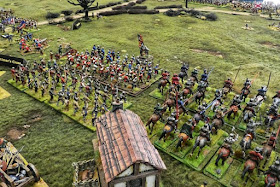






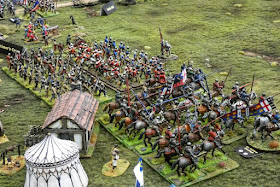



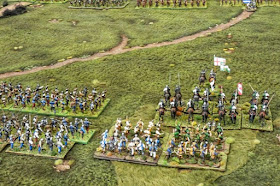






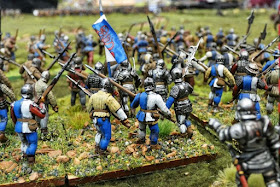








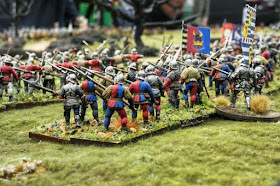











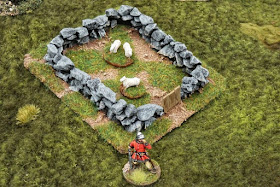










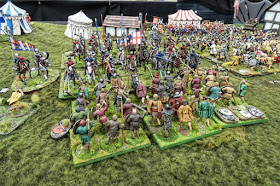
Superb looking battle
ReplyDeleteYes, superb looking battle!
DeleteThank you both. TBF most of the models and scenery are not mine
DeleteA lovely looking battle 👍
ReplyDelete